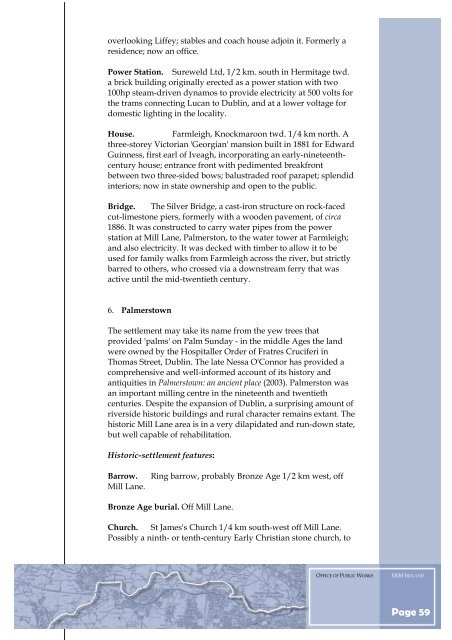Towards a Liffey Valley Strategy Doc. 1 - Kildare.ie
Towards a Liffey Valley Strategy Doc. 1 - Kildare.ie
Towards a Liffey Valley Strategy Doc. 1 - Kildare.ie
Create successful ePaper yourself
Turn your PDF publications into a flip-book with our unique Google optimized e-Paper software.
overlooking <strong>Liffey</strong>; stables and coach house adjoin it. Formerly a<br />
residence; now an office.<br />
Power Station. Sureweld Ltd, 1/2 km. south in Hermitage twd.<br />
a brick building originally erected as a power station with two<br />
100hp steam-driven dynamos to provide electricity at 500 volts for<br />
the trams connecting Lucan to Dublin, and at a lower voltage for<br />
domestic lighting in the locality.<br />
House. Farmleigh, Knockmaroon twd. 1/4 km north. A<br />
three-storey Victorian 'Georgian' mansion built in 1881 for Edward<br />
Guinness, first earl of Iveagh, incorporating an early-nineteenthcentury<br />
house; entrance front with pedimented breakfront<br />
between two three-sided bows; balustraded roof parapet; splendid<br />
interiors; now in state ownership and open to the public.<br />
Bridge. The Silver Bridge, a cast-iron structure on rock-faced<br />
cut-limestone p<strong>ie</strong>rs, formerly with a wooden pavement, of circa<br />
1886. It was constructed to carry water pipes from the power<br />
station at Mill Lane, Palmerston, to the water tower at Farmleigh;<br />
and also electricity. It was decked with timber to allow it to be<br />
used for family walks from Farmleigh across the river, but strictly<br />
barred to others, who crossed via a downstream ferry that was<br />
active until the mid-twent<strong>ie</strong>th century.<br />
6. Palmerstown<br />
The settlement may take its name from the yew trees that<br />
provided 'palms' on Palm Sunday - in the middle Ages the land<br />
were owned by the Hospitaller Order of Fratres Cruciferi in<br />
Thomas Street, Dublin. The late Nessa O'Connor has provided a<br />
comprehensive and well-informed account of its history and<br />
antiquit<strong>ie</strong>s in Palmerstown: an anc<strong>ie</strong>nt place (2003). Palmerston was<br />
an important milling centre in the nineteenth and twent<strong>ie</strong>th<br />
centur<strong>ie</strong>s. Despite the expansion of Dublin, a surprising amount of<br />
riverside historic buildings and rural character remains extant. The<br />
historic Mill Lane area is in a very dilapidated and run-down state,<br />
but well capable of rehabilitation.<br />
Historic-settlement features:<br />
Barrow. Ring barrow, probably Bronze Age 1/2 km west, off<br />
Mill Lane.<br />
Bronze Age burial. Off Mill Lane.<br />
Church. St James's Church 1/4 km south-west off Mill Lane.<br />
Possibly a ninth- or tenth-century Early Christian stone church, to<br />
OFFICE OF PUBLIC WORKS ERM IRELAND<br />
Page 59
















